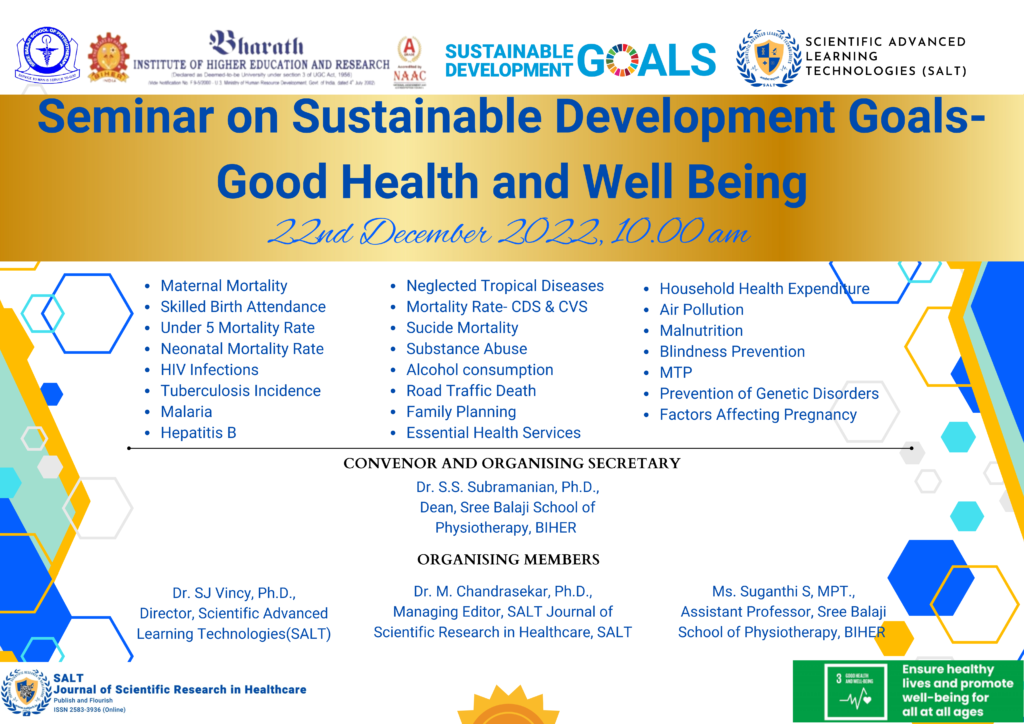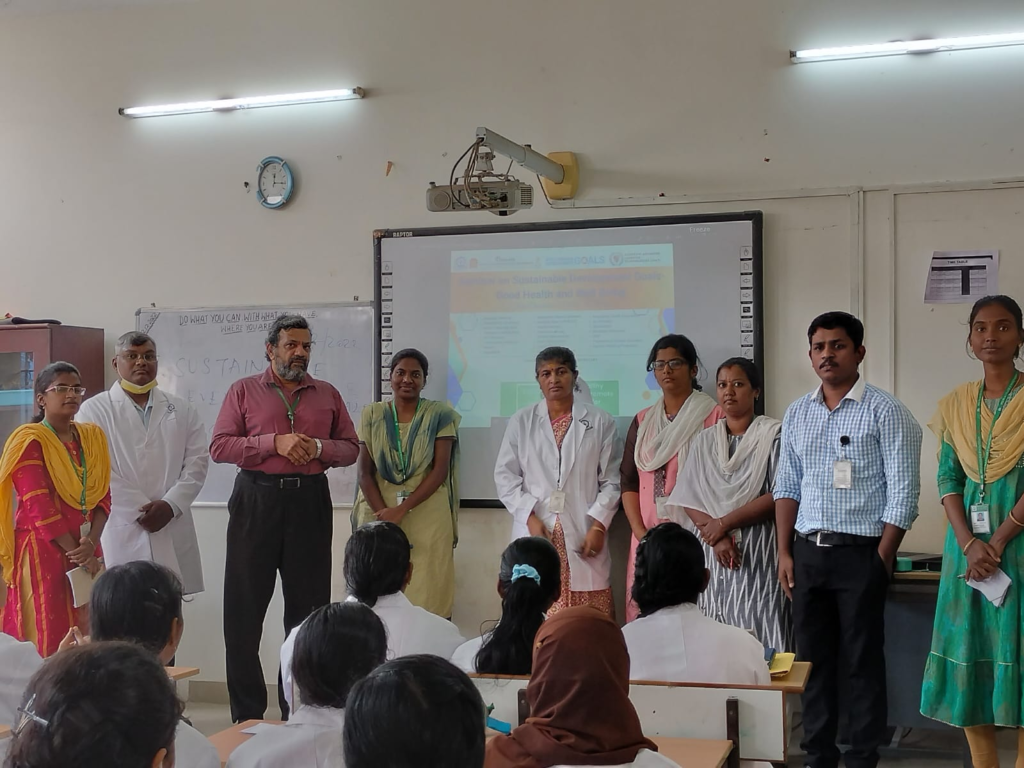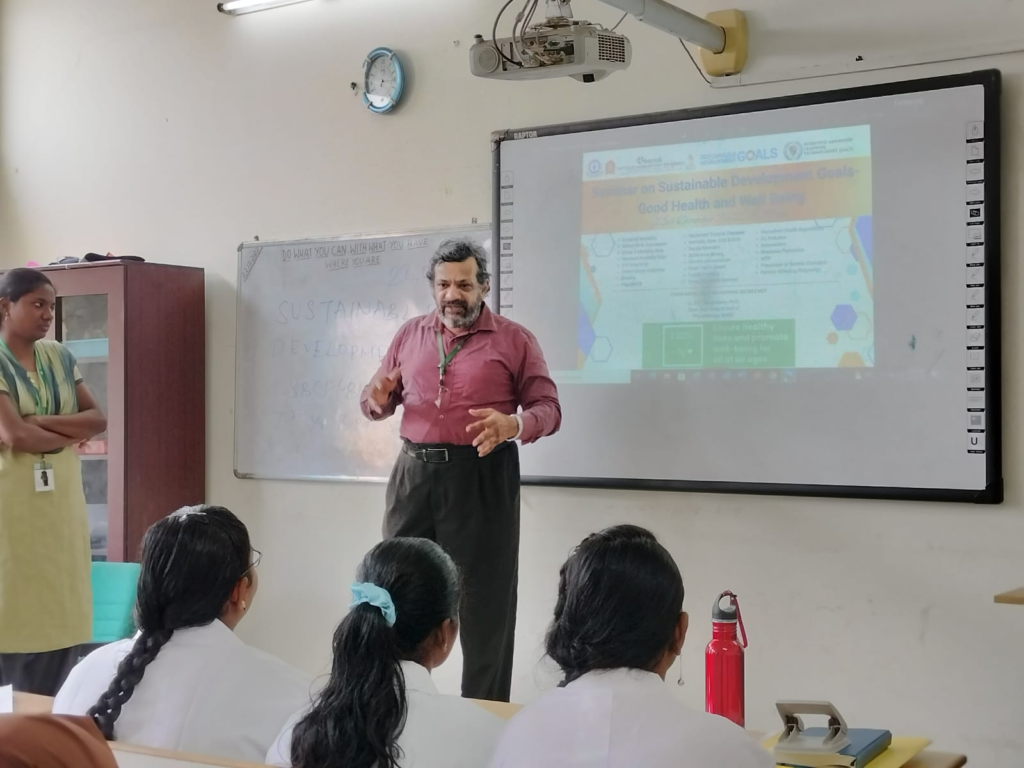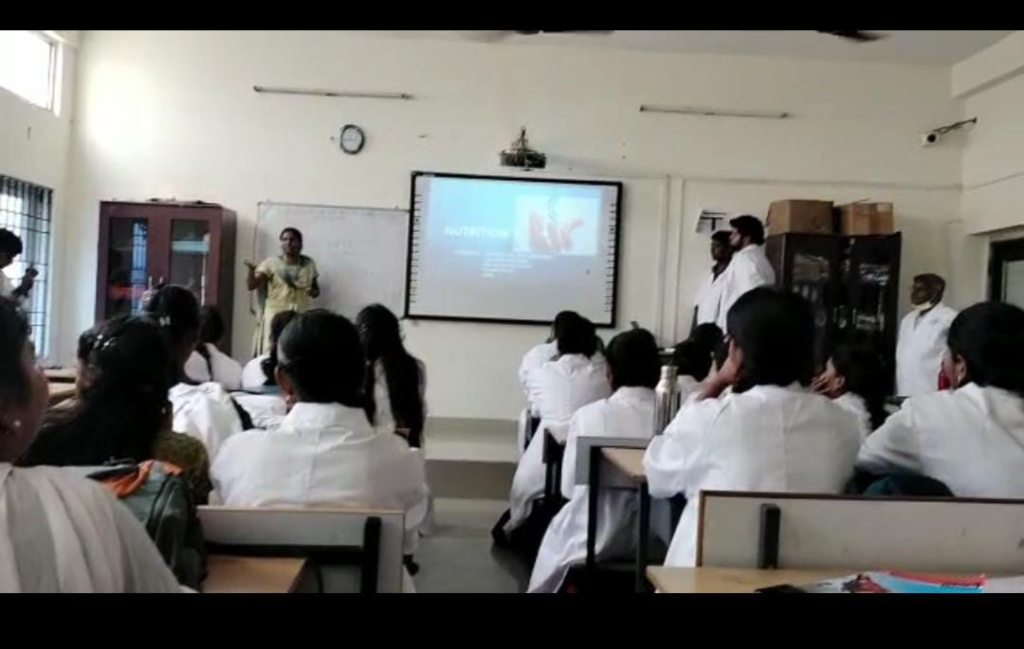SEMINAR ON SUSTAINABLE DEVELOPMENT GOALS- GOOD HEALTH AND WELL BEING
Dr S.S.Subramanian, Dr SJ Vincy, Dr M Chandrasekar, Ms S Suganthi


Program
Dynamics of Seminar by Dr SS Subramanian, Ph.D.,

Motivational Video by Dr SJ Vincy, Ph.D.,
Sustainable Development Growth by Dr M Chandrasekar, Ph.D.,
Nutrition by Ms. S. Suganthi, MPT.,
Presentation by
- Maternal Mortality Ratio by DIANA.M.SG
- Skilled birth attendance by NIVETHA.M
- Under-5 mortality rate by M.NANDHINI
- Neonatal mortality rate by SRUTHI.C.P
- Number of new HIV infections per 1,000 uninfected population, by sex, age and key populations by AARTHI.R
- Tuberculosis Incidence per 100,000 population by MONICA.R.K
- Malaria Incidence Per 1,000 Population by GOKUL.S
- Hepatitis B Incidence Per 100,000 Population by SRIVITHIYA .G
- Number of People Requiring Interventions Against Neglected Tropical Diseases Neglected Tropical Diseases by THIVEYA.K
- Mortality Rate Attributed to Cardiovascular Disease, Cancer, Diabetes or Chronic Respiratory Disease by BHAVANI.P
- Suicide Mortality Rate by METHA RAM.K
- Prevent and Treat Substance Abuse by VIGNESH KUMAR.S
- Alcohol Consumption Per Capita by AKASH.R
- Halve The Number of Road Traffic Deaths by ILLAYABHARATHAN.P
- Proportion of Women of Reproductive Age (aged 15–49 years) Who Have Their Need for Family Planning Satisfied with Modern Methods by NARMADHA SREE. B.G
- Adolescent Birth Rate by PRADEEP.M
- Coverage of Essential Health Services by MOHAMED YASIR.H
- Household Expenditures on Health by GAYATHRI.S
- Mortality Rate from Air Pollution by RAMYA.R
- Elimination of Avoidable Blindness and Visual Impairment by AKASH KUMAR.A.R
- Malnutrition Among Children by SAKTHIVEL. V
- Medical Termination of Pregnancy by HAMNA FATHIMA.F
- Prevention of Genetic Abnormalities by DHARSHAN.P
- Factors Affecting Pregnancy by ASWIN KUMAR.S
Abstract of Presentations
TITLE: NUTRITION
NAME OF THE PRESENTER: SUGANTHI.S.,M.P.T, ASSISTANT PROFESSOR, SREE BALAJI COLLGE OF PHYSIOTHERAPY, BIHER

As we all know good nutrition plays a vital role in the fundamental human health; and also for achieving the Sustainable development goals (SDG’s), to reach the destination as well to progress all the 17 SDG’s nutrition aids.
Nutrition has a hightenened prioritization to steer the goals. Human body requires a needed amount of Macronutrients and Micronutrients in our day today life. These requirements to be fulfilled for the greater achievement and to lead a healthy lifestyle.
As the world strives to the destination of United Nations 17 Sustainable development goals (SDG’s), by 2030 and we entered almost in the 3rd decade, were we need to take an action on Nourishment of all the individuals irrespective of their age. To conclude, As a take home message Nutrition makes the “enormous hill to climb” easier.
TITLE: MATERNAL MORTALITY RATE
NAME OF THE PRESENTER: M.SG.DIANA, Ist YEAR B.P.T, SREE BALAJI COLLEGE OF PHYSIOTHERAPY, BIHER
Maternal mortality rate is the number of female deaths from any cause related to or aggravated by pregnancy or it’s management. It can be calculated by dividing recorded or estimated maternal deaths by total recorded or estimated live births in the same period and multiplying by 100000.
Maternal deaths occurs due to severe bleeding after childbirth, infections, high blood pressure during pregnancy (Preeclampsia, Eclampsia), complications from delivery and unsafe abortion. Maternal mortality rate is high in Sub-Saharan Africa and South Asia which has a lifetime risk of 1 in 38 and 1 in 240 respectively. In India, Assam faces highest maternal deaths whereas states like Kerala, Telangana and Maharashtra faces low maternal deaths. By 2030, “Reduce Global Maternal Mortality to less than 70 per 100000 live births” per year . In addition, all countries should reduce the mortality ratio to less than 140 per 100000.
TOPIC: SKILLED BIRTH ATTENDANT
NAME OF THE PRESENTER: NIVETHA.M, Ist YEAR B.P.T, SREE BALAJI COLLEGE OF PHYSIOTHERAPY, BIHER
1.EXPLANATION : An attendant at birth is the person who assisted the mother in giving birth, whether a physician, a midwife, a nurse, other paramedical personnel, a lay person etc
2.PREVENTION : The education of women. An increase in the use of contraception. More prenatal care. More births in hospitals or with skilled health care providers present. Greater availability of antibiotics, blood transfusions, and treatments for complications
3.CAUSES : Some women cited some disadvantages of delivering with the TBAs which included some traditional practices and lack of infection prevention measures which exposed them to infection and unavailability of certain services such as weighing of the baby. “The baby is not weighed”
4.TRAINING : Between the 1970s and 1990s, the World Health Organization promoted traditional birth attendant (TBA) training as one strategy to reduce maternal and neonatal mortality. To date, evidence in support of TBA training is limited but promising for some mortality outcomes.
TITLE: UNDER 5 MORTALITY RATE
NAME OF THE PRESENTER: NANDHINI.M, FIRST YEAR B.P.T. SREE BALAJI COLLEGE OF PHYSIOTHERAPY, BIHER
The under 5 mortality or child mortality rate is the measure of the number of children per 1000 live births who die before their 5th birthday.
GOALS:- The main goal is to reduce child mortality to less than 25 deaths per 1000 live births per year across all countries by the year of 2030.In the researches done so far shows that child mortality covers more broadly & with a longer term perspective in our world in data entry on child mortality.
TITLE: NEONATAL MORTALITY RATE
NAME OF THE PRESENTER: C.P.SRUTHI, FIRST YEAR B.P.T, SREE BALAJI COLLEGE OF PHYSIOTHERAPY, BIHER
Neonatal mortality rate is defined as the share of newborns per 1,000 live births in a given year who die before reaching 28 days of age.
The causes of neonatal mortality
1. Low birth weight 2. Birth injuries 3. Birth asphyxia
4. Congenital malformations 5. Infections
Number of neonatal deaths : The neonatal, or newborn, period – carries the highest risk of death. It is also the most dangerous period for the newborn’s mother. Each year, 2.4 million newborn die.
TITLE: TUBERCULOSIS INCIDENCE
NAME OF THE PRESENTER: R.K.MONICA., Ist YEAR B.P.T, SREE BALAJI COLLEGE OF PHYSIOTHERAPY, BIHER
As we all know that people who has low immune system, the bacteria becomes active and it causes TB disease .The Sustainable Development Goals (SDG’s) target is to ensure healthy lives and promotes well being for all at all ages.
Nutritional deficiencies are generally associated with an increased risk for contracting TB and has an effect on the severity of the disease.
The Action of SDG’s has targeted a goal to end the Epidemic of TB worldwide by decreasing a lakh of cases to fewer than 20cases.
“The invest to end TB. saves lives”
TOPIC: NEGLECTED TROPICAL DISEASES
NAME OF THE PRESENTER: THIVEYA.K, I st YEAR B.P.T,, SREE BALAJI COLLEGE OF PHYSIOTHERAPY, BIHER
NTDs are found in several countries in Africa, Asia, and Latin America. NTDs are especially common in tropical areas where people do not have access to clean water or safe ways to dispose of human waste. Neglected tropical diseases (NTDs) include several parasitic, viral, and bacterial diseases that cause substantial illness for more than one billion people globally.
Affecting the world’s poorest people, NTDs impair physical and cognitive development, contribute to mother and child illness and death, make it difficult to farm or earn a living, and limit productivity in the workplace. As a result, NTDs trap the poor in a cycle of poverty and disease.
See below for more information on selected neglected tropical diseases:
1.Buruli Ulcer 2.Chagas Disease 3.Cysticercosis 4.Dengue Fever
5.Dracunculiasis (Guinea Worm Disease) 6.Echinococcosis 7.Fascioliasis
8.Human African 9.Trypanosomiasis (African Sleeping Sickness)
10.Leishmaniasis 11.Leprosy (Hansen’s Disease) 12.Lymphatic Filariasis
13.Mycetoma 14.Onchocerciasis 15.Rabies 16.Schistosomiasis
Soil-transmitted Helminths (STH) (Ascaris, Hookworm, and Whipworm)
17.Trachoma
The following six NTDs can be controlled or even eliminated through mass administration of safe and effective medicines or other, effective interventions:
1.Dracunculiasis (Guinea Worm Disease) 2.Lymphatic Filariasis 3.Onchocerciasis
4.Schistosomiasis 5.Soil-transmitted Helminths (STH) (i.e., Ascaris, Hookworm, and Whipworm) 6.Trachoma
Controlling the vectors (e.g., mosquitoes, black flies) that transmit these diseases and improving basic water, sanitation, and hygiene are highly effective strategies against these NTDs.
TITLE: MORTALITY RATE ATTRIBUTED TO CARDIOVASCULAR DISEASE,CANCER,DIABETES OR CHRONIC RESPIRATORY DISEASE.
NAME OF THE PRESENTER: BHAVANI.P, FIRST YEAR B.P.T, SREE BALAJI COLLEGE OF PHYSIOTHERAPY, BIHER
Defined as the percent of 30-year old people who would die before their 70th birthday from any of cardiovascular disease, cancer, diabetes or chronic respiratory disease assuming that they would experience current mortality rates at every age and would not due from any other causes of death.(Eg:-Injuries/HIV/AIDS)
GOALS:- By 2030 reduces premature mortality from non-communicable diseases by one-third in all countries.
TITLE: SUICIDE MORTALITY RATE
NAME OF THE PRESENTER: K.METHA RAM, Ist YEAR B.P.T, SREE BALAJI COLLEGE OF PHYSIOTHERAPY, BIHER
Suicide is death caused by injuring oneself with the intent to die. A suicide attempt is when someone harms themselves with any intent to end their Life, but they do not die as a result of their actions. Many factors can increase the risk of suicide or protect against it.
SUICIDE MORTALITY RATE:
Number of suicide deaths in your divides by population multiplied by 10,0000. Normally Suicide is determined by the interaction between psycho social, biological and psychiatric factors. Suicide is the fourth Leads cause death among 15-29 year old.
Ingestion of pesticide, Hanging and firearms are among the most common method’s of suicide globally. More than 7,00,000 people die due suicide every year. 7% of global suicide occur in Low middle Income countries. Highest Rates of Suicidal mortality rate is observed in Africa while lowest Rate all In East Mediterranean. In India Maharashtra followed by Tamil Nadu is seen with high suicide mortality Rates
GOALS:
By 2030 promote mental health & wellbeing. There is no defined target level of suicide Reduction for this indicator.
TITLE: SUBSTANCE ABUSE
NAME OF THE PRESENTER: S.VIGNESH KUMAR, Ist YEAR B.P.T,, SREE BALAJI COLLEGE OF PHYSIOTHERAPY, BIHER
Substance abuse, also known as drug abuse is the in amounts or by methods which are harmful to the individual or others.
TYPES OF SUBSTANCE ABUSE
Cocaine abuse – Opioid abuse – Heroin abuse – Prescription painkillers
CAUSE OF SUBSTANCE ABUSE
Sleep problems – Chronic pain – Long term tobacco habit – Lack of parental attachment in childhood – Financial difficulties
TITLE: ALCOHOL CONSUMPTION
NAME OF THE PRESENTER: R.AKASH, Ist YEAR B.P.T, SREE BALAJI COLLEGE OF PHYSIOTHERAPY, BIHER
Alcohol consumption, as the term is used in clinical and research applications, refers to the act of ingesting – typically orally – a beverage containing ethanol. Ethyl alcohol or ethanol (CH3CH2OH) is the only type of alcohol that is safe for human consumption.
Excessive drinking can increase your risk of serious health problems, including: Certain cancers, including breast cancer and cancers of the mouth, throat, esophagus and liver. Sudden death if you already have cardiovascular disease.
Cutting down on alcohol will reduce your risk of developing seven types of cancer, as well as reducing your risk of liver or heart disease. It could even lower your blood pressure.
TOPIC: ROAD TRAFFIC ACCIDENT
NAME OF THE PRESENTER: ILAYABHRATHAN P, Ist YEAR B.P.T, SREE BALAJI COLLEGE OF PHYSIOTHERAPY
Road accident is being a massive threat to the entire world. Day by day, the number of vehicles is increasing. Especially it has been a big problem for countries like India, Bangladesh, Nepal, and African countries. We know that the government is working so much hard to prevent an accident on the road.
One of the main Goal of SDG is halve the no. of road traffic
GOALS
1) By 2020 halve the no. of global death and injures from road traffic accident
2) While most SDG target are set for 2030
3) This is set to be achieved for 2020
Road accident is most unwanted thing to happen to a road user, though they happen quite often. The most unfortunate thing is that we don’t learn from our mistakes on road. Most of the road users are quite well aware of the general rules and safety measures while using roads but it is only the laxity on part of road users, which cause accidents and crashes. Main cause of accidents and crashes are due to human errors. We are elaborating some of the common behaviour of humans which results in accident.
1.Speed 2. Using mobile phone While driving 3.Distracted diver 4.Fatigue 5.Missed vehicle maintenance 6.Beating the red light 7.Poor road condition 8.Bad whether 9.Driving under the influence of drug or alcohol
The annual no. of death from road injures per 1,00,000 deaths included those whole drivers and passengers.
TITLE: FAMILY PLANNING
NAME OF THE PRESENTER: B.G.NARMADHA SREE, Ist YEAR B.P.T, SREE BALAJI COLLEGE OF PHYSIOTHERAPY, BIHER
India is the first country of the developing nations that initiated a state-supported family planning program. Furthermore, this type of program is a must if you look at the population of a country like India. Also, the statistics show a great rise in the population throughout the decade. In addition, India is the second-largest population of the world with a population of more than 1.3 billion. Furthermore, national fertility is also quite high and every 20 days the population rise by 1 million people.
Moreover, according to the statistician of the U.N (United Nations), the population of India will exceed the population of China by the year 2028. Most noteworthy, the Indian government recognized this problem and initiated a family planning measure some time ago to control this problem.Controlling the number of children you have by using birth control.
CONTRACEPTIVE METHODS:
There are two types of methods,
1. Natural Contraceptive method
2. Artificial Contraceptive method
NATURAL METHOD:
*Withdrawal *Abstinence *SDM
ARTIFICIAL METHOD: They are of two division ,
- Temporary
- Permanent
TEMPORARY:
*Barrier *Hormonal *IUCD(Copper – T)
PERMANENT:
* Tubectomy * Vasectomy
TITLE: ADOLESCENT BIRTH RATE
NAME OF THE PRESENTER: M. PRADEEP, Ist YEAR B.P.T, SREE BALAJI COLLEGE OF PHYSIOTHERAPY, BIHER
The annual number of births to women aged 15-19 years per 1,000 women in that age group. It is also referred to as the age-specific fertility rate for women aged 15-19. Global and regional estimates are based on population-weighted averages using the number of women aged 15-19 years as the weight. They are presented only if available data cover at least 50% of total number of women aged 15-19 years in the regional or global groupings.
A well-functioning and integrated national or sub national CRVS system will universally register and certify vital events, including live births, stillbirths and deaths that occur in the country or administrative area. Birth and death certificates should be issued as part of the CRVS system, allowing the compilation, analysis and dissemination of information through vital statistics agencies, including population characteristics (e.g. sex, date of birth/death, place of birth/death, place of usual residence) and cause-of-death information. Some CRVS systems will also register and certify other important vital events within the population, such as adoptions, marriages and divorces.
DATA SOURCES:
The four main data sources for this indicator are:
- Civil registration and vital statistics (CRVS) systems
- Routinely collected administrative data
- Population-based household surveys
- Nationally representative census data
INDICATOR CALCULATION: The indicator is calculated as the number of live births to women aged 15−19 years per 1000 women aged 15–19 during a specified time period. The calculation is as follows:
(The number of women aged 15–19 years with a live birth in a specified period / Total number of women aged 15–19 years old [per 1000] in a specified time period)
TITLE: COVERAGE OF ESSENTIAL HEALTH SERVICES
NAME OF THE PRESENTER: MOHAMED YASIR, FIRST YEAR B.P.T, SREE BALAJI COLLEGE OF PHYSIOTHERAPY, BIHER
Coverage of essential health services is defined as the average coverage of essential services based on tracer interventions that include reproductive, maternal, newborn and child health, infectious diseases, non-communicable diseases and service capacity and access, among the general and the most disadvantaged population.
GOAL: By 2030 achieve universal health coverage including financial risk protection, access to quality essential health-care services and access to safe, effective, quality and affordable essential medicines and vaccines for all.
TOPIC: HOUSEHOLD EXPENDITURE ON HEALTH
NAME OF THE PRESENTER: GAYATHRI.S, FIRST YEAR B.P.T, SREE BALAJI COLLEGE OF PHYSIOTHERAPY, BIHER
Household expenditure is divided into three: Fixed – Irregular – Discretionary
Fixed-These are regular payments where the amount paid does not vary.
Irregular-This is where the timing and/or amount of spending will vary.
Discretionary-Non-essential spending, this is spending on wants rather than needs.
Health comes under irregular expenditure.
DEFINITION:-Proportion of population with large household expenditures on health as a share of total household expenditure on health. Health expenditures also includes provision of health services,family planning activities,nutrition activities and emergency aid designated for health.
GOALS:-The main goal of SDG is to achieve universal health coverage including financial risk, protection,access to quality, essential health care services and access to safe,effective, quality and affordable essential medicines and vaccines for all by 2030.
TITLE: MORTALITY RATE OF AIR POLLUTION
NAME OF THE PRESENTER: R.RAMYA, I YEAR BPT, SREE BALAJI COLLEGE OF PHYSIOTHERAPY, BIHER
As we all know air pollution is one of the world’s largest health and environmental problems. It develops in two contexts indoor air pollution and outdoor air pollution. Pollution enter the Earth’s atmosphere in many different ways, most of the air pollution is created by people.
Air pollution is the risk factors for deaths attributed to millions of deaths each year, annual number of deaths attributed to household and ambient air pollution per 100,000 people’s.
It is not only takes your from people’s lives, but also had large effect on quality while they are still living. So we need to prevent air pollution by following some ways.
“LESS AIR POLLUTION IS THE ANSWER TO A HEALTHY LIFE SOLUTION.”
TITLE: BLINDNESS PREVENTION
NAME OF THE PRESENTER: A.R.AKASH KUMAR, FIRST YEAR B.P.T, SREE BALAJI COLLEGE OF PHYSIOTHERAPY, BIHER
Blindness is the inability to see anything, including light. If you’re partially blind, you have limited vision. For example, you may have blurry vision or the inability to distinguish the shapes of objects. Complete blindness means you can’t see at all. Legal blindness refers to vision that’s highly compromised. What a person with regular vision can see from 200 feet away, a legally blind person can see from only 20 feet away.
Seek medical attention right away if you suddenly lose the ability to see. Have someone bring you to the emergency room for treatment. Don’t wait for your vision to return. Depending on the cause of your blindness, immediate treatment may increase your chances for restoring your vision. Treatment may involve surgery or medication.
CAUSES OF BLINDNESS
1.Trachoma
2.Diabetic retinopathy
3.Optic Retinitis
4.Glaucoma
5.Macular degeneration
6.Infection on Sclera, Retina and cornea
7.Traumatic injuries
PREVENTION OF BLINDNESS
1.Quite smoking
2.Giving rest to your eye
3.Wear a safety lense
4.Avoid long hour uses of Digitals
5.Eye ball exercises
6.Eating Nutritious rich foods
TITLE: MALNUTRITION AMONG CHILDREN
NAME OF THE PRESENTER: SAKTHIVEL V, Ist YEAR B.P.T,, SREE BALAJI COLLEGE OF PHYSIOTHERAPY, BIHER
Malnutritionoccurs when an organism gets too few or too many nutrients, resulting in health Problems. Specifically, it is “a deficiency, excess, or imbalance of energy, protein and other Nutrients” which adversely affects the body’s tissues and form. Malnutrition is not receiving. The correct amount of nutrition. Malnutrition is increasing in children under the age of five due to providers who cannot afford or do not have access to adequate nutrition. Malnutrition is a category of diseases that includes under nutrition and over nutrition.
Under nutrition is a lack of nutrients, which can result in stunted growth, wasting, and underweight. A surplus of nutrients causes over nutrition, which can result.In some developing countries, Over nutrition in the form of obesity is beginning. To appear within the same communities as Under nutrition. Most clinical studies use the Term ‘malnutrition’ to refer to under nutrition.
Among the targets of the Sustainable Development Goals (SDG), target 2.2 focuses on ending malnutrition, including stunting, And wasting and overweight among under-5 Children by 2030. These conditions increasingly co-exist within communities Forming the triple burden of malnutrition, Which negatively affects human health and the Society, a situation currently exacerbated by the COVID-19 pandemic.
“DISEASE PREYS ON A WEAK AND MALNOURISHED MIND”
TITLE: MEDICAL TERMINATION OF PREGNANCY (MTP)
NAME OF THE PRESENTER: F.HAMNA FATHIMA, FIRST YEAR B.P.T, SREE BALAJI COLLEGE OF PHYSIOTHERAPY, BIHER
MTP or Medical Termination of Pregnancy is a procedure of terminating pregnancy using medications or using surgical procedures
SURGICAL PROCEDURES.
1.Aspiration of endometrium cavity within 14 days of missed period
2.After introduction of speculum the cervix is steadied with Allis forceps
3.Most common [DandC] procedure Dilation and Curretage has less side effects and less time.
MEDICATIONS:
1.Mifepristone acts as an antagonist and blocks the effect of progesterone
2.Addition of low dose prostaglandins improves efficiency of 1st trimester abortion
3.Methotrexate 50 mg is given before 56 days of gestation
INDICATIONS:
1.If the female has any physical or mental health issues
2. Due to sexual abuse
3.If the unborn child has abnormalities
4.Due to failure of conception etc.
COMPLICATIONS:
1.Continuous bleeding with clots for 14 days
2.Rashes and infections
3.Abnormal abdomen pain
LEGALISED:
1.The Indian Abortion Law comes under MTP
2.It is enacted on 1971
3.Came to effect on 1972
4.Should be done only by Medical Practitioners
5.It should be reported to the director of health and service of the state.
TITLE : FACTORS INFLUENCING PREGNANCY
NAME OF THE PRESENTER: S.ASWIN KUMAR, FIRST YEAR B.P.T, SREE BALAJI COLLEGE OF PHYSIOTHERAPY, BIHER
Pregnancy occurs when a sperm fertilizes an egg after its release from the ovary during ovulation.
Factory influencing pregnancy
1. High blood pressure 2. Polycystic ovary syndrome 3. Diabetes 4. Kidney disease
5. Autoimmune disease 6. Thyroid disease 7. Obesity 8. HIV/AIDS
9. Age factors 10. Multiple gestation 11. Previous preterm birth